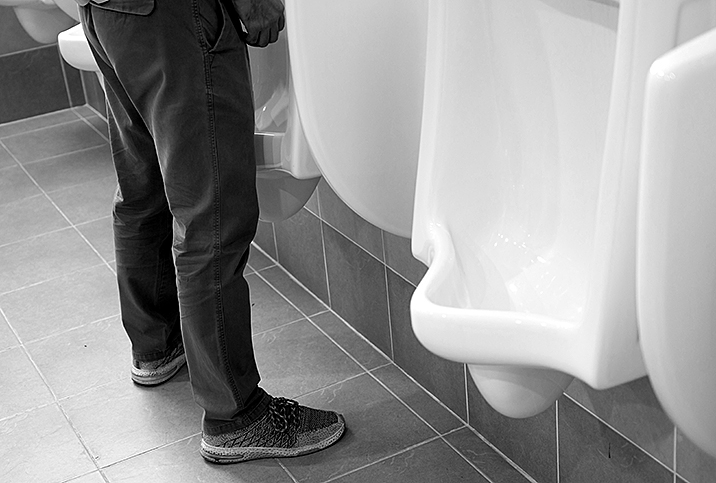How Is Sexual Function Affected by Prostate Procedures?

There's nothing like the prospect of an upcoming medical procedure or surgery to send the ol' anxiety into overdrive. Heck, even a routine cavity filling is enough to keep people up the night before. And when a potential side effect is sexual dysfunction, as is the case with many procedures used to treat an enlarged prostate gland—also known as benign prostatic hyperplasia, or BPH—the situation can be even more nerve-racking.
The good news: BPH surgery is far from the end of your sex life. While sexual side effects are sometimes associated with certain BPH procedures, the risk isn't uniform across all types. And if you do end up experiencing them, often a number of treatment options are available.
Here's the lowdown on the types of BPH surgeries available, the risks associated with each, and how you can manage and cope with the potential side effects.
Types of BPH procedures and surgeries
An enlarged prostate primarily causes urinary problems by blocking the flow of urine out of the bladder. A number of different procedures and surgeries are used to treat BPH, each differing in approach and side effects. However, both have the same goal: to reduce the pressure of your prostate on your urethra, allowing a clear pathway for urine to flow.
The best treatment option will largely depend on your unique circumstances, including prostate size, medical background and other factors. Following are a few of the most common options.
Minimally invasive with local anesthetic
In surgery, a general rule of thumb is the less invasive the procedure, the lower the risk it carries, and prostate surgery is no exception. A few different procedures can be performed under local anesthesia at a doctor's office or another outpatient facility, which results in a lower risk of sexual side effects and a quicker recovery time. Some options include:
- UroLift: A procedure in which a device is inserted through the urethra to place implants that lift prostate tissue out of the way, so it no longer blocks the urethra.
- Rezūm: A procedure in which a device is inserted through the urethra to inject steam into the prostate, ultimately shrinking it.
- Transurethral microwave therapy (TUMT): A procedure in which a small microwave antenna is inserted through the urethra (yes, really) to emit heat and destroy excess prostate tissue.
"[With UroLift], physicians are moving tissue and not ablating it, which does not impact sexual function," said Gregg Eure, M.D., a urologist at Urology of Virginia in Virginia Beach. Ablation is the removal or destruction of tissue. (Full disclosure: Eure is a paid consultant for NeoTract/Teleflex Interventional Urology, the company that developed the UroLift System.)
Within two weeks, most men will be able to resume sex after UroLift even if full recovery takes longer.
Rezūm is typically not associated with sexual side effects, either, but TUMT does carry some risk of retrograde ejaculation, a condition in which semen goes into the bladder instead of out of the urethra, resulting in little or no semen being ejaculated after orgasm.
Of course, these procedures aren't right for everybody. They work best on small prostates, and since the prostate can regrow, they may need to be repeated, Eure said.
Minimally invasive with general or spinal anesthetic
Some surgeries can be done as minimally invasive outpatient procedures but require a more powerful anesthetic. These include certain transurethral procedures, such as:
- Transurethral incision of the prostate (TUIP): A procedure in which an instrument called a resectoscope is inserted through the urethra to make a small incision or two where the prostate and bladder are connected, opening the urinary channel.
- Transurethral electrovaporization of the prostate (TUVP): A procedure in which a resectoscope is inserted through the urethra to vaporize excess prostate tissue with an electric current.
Both TUIP and TUVP provide a similar level of relief as transurethral resection of the prostate, the "gold standard" of BPH surgery, but have a lower risk of side effects.
TUIP has a lower risk of retrograde ejaculation and a low risk of erectile dysfunction (ED). It's also better suited for smaller prostates and may need to be repeated. TUVP, on the other hand, has a high risk of retrograde ejaculation and a lower risk of erectile dysfunction. It can be performed on larger prostates and has a lower reoperation rate.
Newer technologies, such as laser therapy, have been growing in popularity. Laser therapies can be performed at an outpatient facility, are less likely to require repeat treatment and work on all prostate sizes. A couple of common types include:
- Laser enucleation of the prostate (HoLEP or ThuLEP): A procedure in which a lighted instrument is inserted into the urethra to remove obstructive tissue from the prostate via laser.
- GreenLight: A procedure in which an instrument called a cystoscope, which contains a fiber-optic camera, is inserted into the urethra to vaporize obstructive tissue from the prostate via laser.
One of the drawbacks of laser therapy is the high incidence of retrograde ejaculation.
"After HoLEP, most men will have no ejaculation," said Lance Walsh, M.D., Ph.D., a physician at the Advanced Urology Institute at Titus in Mount Pleasant, Texas. "Erectile dysfunction happens, but is less common."
Laser therapies are relatively novel BPH procedures, and more nascent technologies are also entering the game. One of the newest is Aquablation, a procedure in which a device is inserted through the urethra to create a surgical map of the prostate and remove excess tissue with a high-powered waterjet.
While Aquablation typically requires an overnight stay, it does have the benefit of a lower risk of retrograde ejaculation, although it's not an insignificant risk.
More invasive procedures
People suffering from more severe BPH symptoms may need a procedure that is a little more involved.
"The higher the level we go in terms of the treatment, the more open the urethra becomes and the more symptom relief a person gets, [but] the more likely it is that a person will develop sexual dysfunction," said S. Adam Ramin, M.D., medical director of Urology Cancer Specialists in Los Angeles.
Given its efficacy in relieving symptoms and long track record of use, the go-to for BPH treatment historically is transurethral resection of the prostate (TURP), a procedure that utilizes a resectoscope inserted through the urethra to allow the doctor to identify and chip away excess prostate tissue. The resectoscope contains an electrical wire loop that cuts tissue and seals blood vessels.
Although TURP provides significant relief, risks are inherent. It's major surgery, requiring one to three days in the hospital and several weeks of recovery time. It also carries a high risk of retrograde ejaculation and some risk of erectile dysfunction. The surgeon's experience and the technique used are important factors in reducing these risks, Ramin said.
Measures are always available to prevent, treat and cope with sexual side effects.
"When we're doing a transurethral resection of the prostate, the reason patients may develop erectile dysfunction is that the electricity from the loop may transmit down the prostate and electrically damage the nerves," Ramin explained. "So, as we're doing these procedures, we need to be careful about how much electrical energy we're applying, what part of the prostate is being treated and how deep we're doing the resection."
The most invasive procedure for BPH is reserved for large prostates and severe symptoms, given its high risk of side effects. Simple prostatectomy is a procedure in which the prostate capsule is cut open, partly removed and then closed again.
Walsh explained that this method involves making an incision in the abdomen and using either robotic instruments (in a robot-assisted laparoscopic approach) or the surgeon's finger (in an open approach) to open the prostate capsule and remove the prostate.
The open approach has been in use longer and patients can still choose it as an option, but Ramin said more surgeons are recommending the robotic laparoscopic method.
"The risk of complications in experienced hands goes down significantly with robotic laparoscopic surgery," he added. "There's much less chance of bleeding, much less pain involved, and the recovery is faster."
Both methods typically result in retrograde ejaculation and carry a moderate risk of erectile dysfunction, but the robot-assisted laparoscopic approach is better at preserving the nerves that aid sexual function.
Preventing and treating sexual side effects
Before surgery, one of the best steps a man can take to reduce the risk of sexual side effects is to maintain a healthy lifestyle.
"Keeping good heart flow, low blood pressure [and] maintaining physical activity all affects sexual function," Eure said.
Men have better odds of retaining sexual function if they don't have diabetes, don't smoke, are not obese and control their blood pressure, according to Ramin. After surgery, the best course of treatment depends on symptoms and the procedure chosen. One of the easiest ways to stave off erectile dysfunction, for example, is simply to stimulate the penis early and often.
"We encourage our patients to start sexual activity as early as a week to two weeks after surgery," Ramin said, although this guideline may vary in each case. He often recommends patients enjoy sexual activity at least two to three times a week, either solo or with a partner. He often prescribes a daily dose of Cialis to increase blood flow to the penis.
"It's very important to try to get erections after prostate surgery to keep the vascular supply of the penis working properly," he explained.
A medical-grade vacuum erection device may also be recommended after certain surgeries.
"A person can place their penis in a vacuum pump and just essentially pump the penis to stretch it and increase blood flow to prevent it from going into atrophy or getting shorter," Ramin explained.
If all else fails, penile implant surgery may be recommended.
Unfortunately, there's not much that can be done for retrograde ejaculation, but it's not harmful and won't affect your ability to have sex or affect the quality of your orgasms. Ramin said a man's sensation will be just like it was before surgery.
Retrograde ejaculation can cause issues if a couple is trying to conceive, but otherwise it isn't a serious medical issue, said Josh Gonzalez, M.D., who works as a sexual health advisor for Astroglide, a lubricant brand. With the help of assisted reproductive technology (ART), conception may still be possible.
Gonzalez acknowledged retrograde ejaculation can take an emotional toll. If you feel insecure or upset about your inability to ejaculate, you may benefit from therapy.
The bottom line
Nobody wants surgical side effects to interfere with their sex life, but if you're experiencing classic BPH symptoms, they shouldn't be ignored.
"Besides affecting quality of life, leaving BPH unattended can lead to increased UTIs, and bladder and kidney damage," Walsh said.
If you do need surgery, it doesn't mean you can no longer have a rewarding sex life. Measures are always available to prevent, treat and cope with sexual side effects. The relief you'll experience after surgery will likely be worth any challenges you encounter as a result.


















